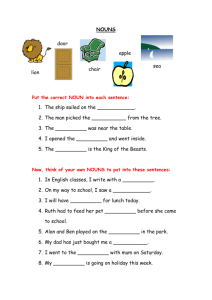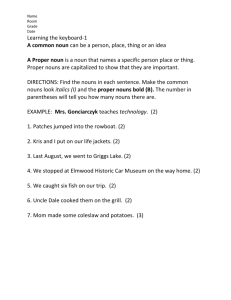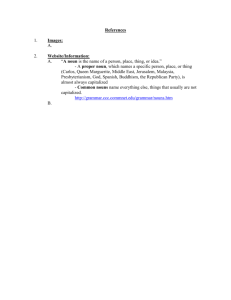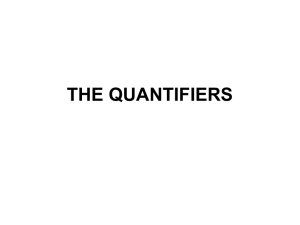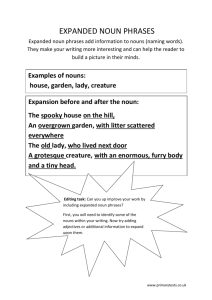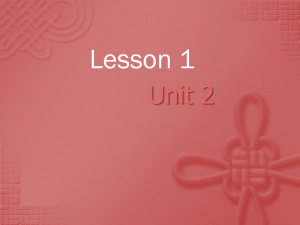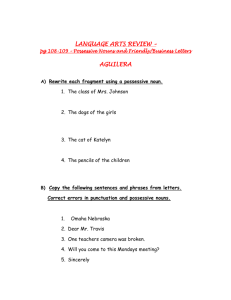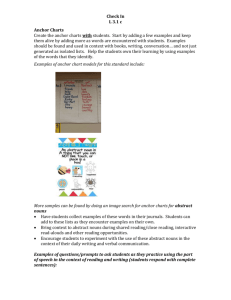30 Use the articles a, an, and the appropriately
advertisement
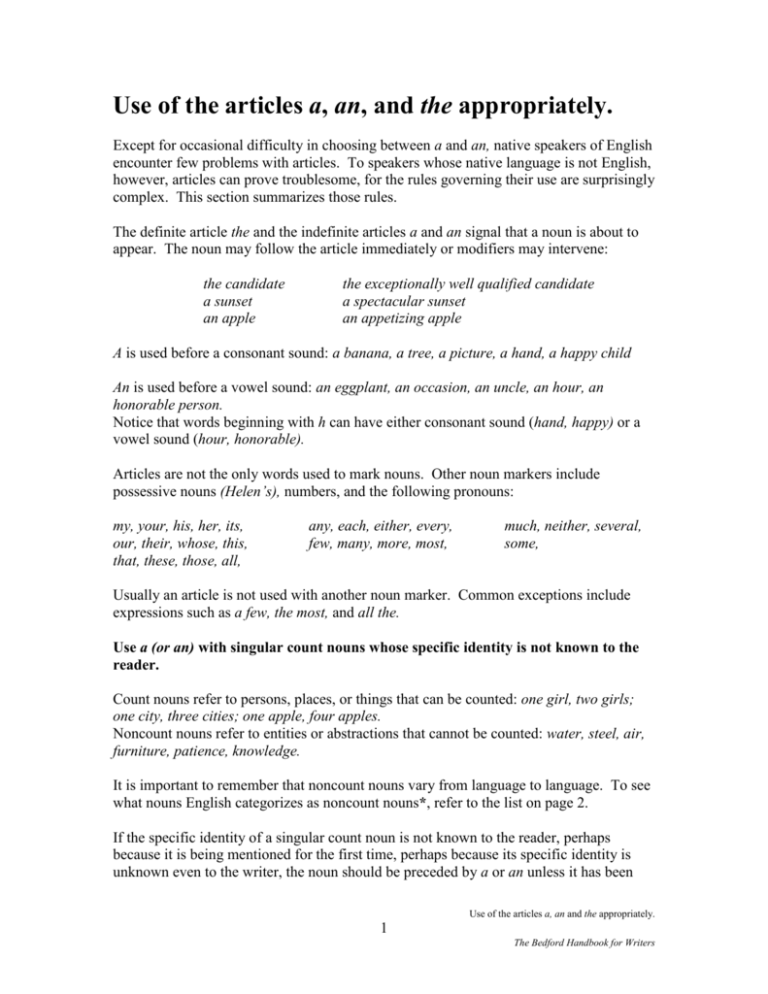
Use of the articles a, an, and the appropriately. Except for occasional difficulty in choosing between a and an, native speakers of English encounter few problems with articles. To speakers whose native language is not English, however, articles can prove troublesome, for the rules governing their use are surprisingly complex. This section summarizes those rules. The definite article the and the indefinite articles a and an signal that a noun is about to appear. The noun may follow the article immediately or modifiers may intervene: the candidate a sunset an apple the exceptionally well qualified candidate a spectacular sunset an appetizing apple A is used before a consonant sound: a banana, a tree, a picture, a hand, a happy child An is used before a vowel sound: an eggplant, an occasion, an uncle, an hour, an honorable person. Notice that words beginning with h can have either consonant sound (hand, happy) or a vowel sound (hour, honorable). Articles are not the only words used to mark nouns. Other noun markers include possessive nouns (Helen’s), numbers, and the following pronouns: my, your, his, her, its, our, their, whose, this, that, these, those, all, any, each, either, every, few, many, more, most, much, neither, several, some, Usually an article is not used with another noun marker. Common exceptions include expressions such as a few, the most, and all the. Use a (or an) with singular count nouns whose specific identity is not known to the reader. Count nouns refer to persons, places, or things that can be counted: one girl, two girls; one city, three cities; one apple, four apples. Noncount nouns refer to entities or abstractions that cannot be counted: water, steel, air, furniture, patience, knowledge. It is important to remember that noncount nouns vary from language to language. To see what nouns English categorizes as noncount nouns*, refer to the list on page 2. If the specific identity of a singular count noun is not known to the reader, perhaps because it is being mentioned for the first time, perhaps because its specific identity is unknown even to the writer, the noun should be preceded by a or an unless it has been Use of the articles a, an and the appropriately. 1 The Bedford Handbook for Writers preceded by another noun marker. A (or an) usually means “one among many” but can also mean “any one.” Examples: a Mary Beth arrived in limousine. an We are looking for apartment close to the lake. ► Do not use a (or an) with plural nouns or with noncount nouns. Because a (or an) has a singular meaning, it is never used to mark a plural noun. As a child I earned money by delivering a newspapers. A (or an) is not used to mark noncount nouns, such as sugar, gold, honesty, or jewelry. Claudia asked her mother for an advice. If you want to express an amount of something designated by a noncount noun, you can often add a count noun in front of it: a quart of milk, a piece of furniture, a bar of soap. pound of Mother asked us to pick up a sugar at the corner store. Note: A few noncount nouns may also be used as count nouns: Bill loves chocolate. Bill offered me a chocolate. *COMMONLY USED NONCOUNT NOUNS Food and drink: bacon, beef, beer, bread, cereal, cheese, chicken, broccoli, butter, chocolate, coffee, corn, cabbage, candy, cream, fish, flour, fruit, cauliflower, celery, ice cream, lettuce, meat, milk, oil, pasta, rice, salt, spinach, sugar, tea, water, wine, yogurt Nonfood substances: air, cement, coal, dirt, gasoline, gold, paper, petroleum, plastic, rain, silver, snow, soap, steel, wood, wool Abstract nouns: advice, anger, beauty, confidence, courage, employment, fun, happiness, health, honesty, information, intelligence, knowledge, love poverty, satisfaction, truth, wealth Other: biology (and other areas of study), clothing, equipment, furniture, homework, jewelry, luggage, lumber, machinery, mail, money, news, poetry, Use of the articles a, an and the appropriately. 2 The Bedford Handbook for Writers pollution, research, scenery, traffic, transportation, violence, weather, work ► Use the with most nouns whose specific identity is known to the reader. The definite article the is used with most nouns whose identity is known to the reader. **For exceptions, see page 4.) Usually the identity will be clear to the reader for one of the following reasons: 1. The noun has been previously mentioned. 2. A phrase or clause following the noun restricts its identity. 3. A superlative such as best or most intelligent makes the noun’s identity specific. 4. The noun describes a unique person, place, or thing. 5. The context or situation makes the noun’s identity clear. the A truck loaded with dynamite cut in front of our van. When truck skidded a few seconds later, we almost plowed into it. The noun truck is preceded by A when it is first mentioned. When the noun is mentioned again, it is preceded by the since readers now know the specific truck being discussed. the Bob warned me that gun on the top shelf of the cupboard was loaded. The phase on the top shelf of the cupboard identifies the specific gun. the Our petite daughter dated tallest boy in her class. The superlative tallest restricts the identity of the noun boy. the During an eclipse, one should not look directly at sun. There is only one sun in our solar system, so its identity is clear. the Please don’t slam door when you leave. Both the speaker and the listener know which door is meant. **Do not use the with plural or noncount nouns meaning “all” or “in general”; do not use the with most proper nouns. When a plural or a noncount noun means “all” or “in general” it is not marked with the. Use of the articles a, an and the appropriately. 3 The Bedford Handbook for Writers The fountains are an expensive element of landscape design. In some parts of the world, the rice is preferred to all other grains. Although there are many exceptions, as a rule the is not used with proper nouns. Do not use the with names of persons (Jessica Webner), names of streets, cities, and states, (Prospect Street, Detroit, Idaho), names of continents and most countries (Europe, South America, Costa Rica, India), and the proper names of most lakes and single mountains (Lake Geneva, Mount Everest). Plural proper nouns such as the United States, the Great Lakes, and the Alps are exceptions. Use of the articles a, an and the appropriately. 4 The Bedford Handbook for Writers
